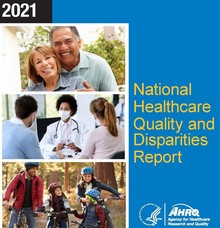| March 1, 2022, Issue #803  Asthma hospitalizations for children aged 2 to 17 years in 2018 were more than 60 percent higher in large central metropolitan areas than in any other area, with over 116 occurring among every 100,000 children compared to just over 71 per every 100,000 in other areas. (Source: AHRQ, 2021 National Healthcare Quality and Disparities Report D-86) | A new AHRQ-funded study published in JAMA Network Open found that more than 400 long-term care facilities participating in the AHRQ Safety Program for Improving Antibiotic Use were able to significantly reduce antibiotic use. This included reductions in the use of fluoroquinolones, a class of antibiotics known to cause adverse effects in older adults. Up to 75 percent of the antibiotics prescribed in long-term care facilities are inappropriate, which can contribute to antibiotic resistance, according to previous studies. AHRQ's Toolkit To Improve Antibiotic Use in Long-Term Care is based on the experiences of the facilities that participated in the program. It includes resources, webinars and practical tools frontline staff can use to incorporate antibiotic stewardship principles into routine decision making through a novel framework called the Four Moments of Antibiotic Decision Making. Access the AHRQ press release for more details.  Patients who utilized opioids chronically before common surgeries may increase their use of the pain medications postoperatively and increase healthcare spending as a result. An AHRQ-funded review of claims data from over 53,000 privately insured patients found that those who increased their opioid use by 20 percent in the year after surgery spent $64,000 more on healthcare. Additionally, those who reduced their use by 20 percent spent around $1,100 less, suggesting an opportunity to reduce expenditures through opioid reduction investments, though further review to identify specific spending drivers is necessary. Access the study abstract in Anesthesia & Analgesia. | AHRQ's Patient Safety Network (PSNet) highlights journal articles, books and tools related to patient safety. Articles featured this week include: Review additional new publications in PSNet's current issue or access recent cases and commentaries in AHRQ's WebM&M (Morbidity and Mortality Rounds on the Web).  Researchers looking for the latest research on topics ranging from diagnostic safety to primary care to health information technology can find it in AHRQ's Research Studies database. This resource offers summaries of nearly 10,000 published articles funded by AHRQ or authored by AHRQ researchers. It includes summaries of journal articles, book chapters and working papers from 2013 to present. Updated monthly, the resource allows searching by keyword and provides links to journal abstracts. Access the database. | Using AHRQ's Comprehensive Unit-based Safety Program, or CUSP, Henry Ford Hospital in Detroit has reduced the incidence of central line-associated bloodstream infection (CLABSI) in its hematology-oncology unit by 75 percent between July 2020 and June 2021. The reduction not only prevented patient harm, it also saved an estimated $385,000 in healthcare costs that would have been incurred to treat the infections. Before implementing the program, the staff weren't following a standardized protocol when patients received peripherally inserted central catheter (PICC) lines. After CUSP was put in place, the process by which PICC lines are inserted and maintained is clear and consistent, and infections have declined. Find out more in a new AHRQ Impact Case Study. | AHRQ in the Professional Literature Development of a parent-reported outcome measure for febrile infants ≤60 days old. Aronson PL, Fleischer E, Schaeffer P, et al. Pediatr Emerg Care. 2022 Feb;38(2):e821-e7. Access the abstract on PubMed®. Home blood pressure data visualization for the management of hypertension: designing for patient and physician information needs. Koopman RJ, Canfield SM, Belden JL, et al. BMC Med Inform Decis Mak. 2020 Aug 18;20(1):195. Access the abstract on PubMed®. Theory-based development of an implementation intervention using community health workers to increase palliative care use. Kubi B, Enumah ZO, Lee KT, et al. J Pain Symptom Manage. 2020 Jul;60(1):10-19. Epub 2020 Feb 22. Access the abstract on PubMed®. A chart review of substance use screening and related documentation among adolescents in outpatient pediatric clinics: implications for practice. Kuhns LM, Carlino B, Greeley K, et al. Subst Abuse Treat Prev Policy. 2020 May 25;15(1):36. Access the abstract on PubMed®. Significant gains in rheumatoid arthritis quality measures among RISE Registry practices. Izadi Z, Schmajuk G, Gianfrancesco M, et al. Arthritis Care Res. 2022 Feb;74(2):219-28. Epub 2021 Dec 27. Access the abstract on PubMed®. Primary care health care use for patients with type 2 diabetes during the COVID-19 pandemic. Misra-Hebert AD, Hu B, Pantalone KM, et al. Diabetes Care. 2021 Sep;44(9):e173-e4. Epub 2021 Jul 14. Access the abstract on PubMed®. Hospital location and socioeconomic disadvantage of emergency general surgery patients. Langston DM, Oslock WM, Paredes AZ, et al. J Surg Res. 2021 May;261:376-84. Epub 2021 Jan 22. Access the abstract on PubMed®. Relative risks of adverse events among older adults receiving opioids versus NSAIDs after hospital discharge: a nationwide cohort study. Herzig SJ, Anderson TS, Jung Y, et al. PLoS Med. 2021 Sep 27;18(9):e1003804. Access the abstract on PubMed®. Contact Information For comments or questions about AHRQ News Now, contact Bruce Seeman, (301) 427-1998 or Bruce.Seeman@ahrq.hhs.gov. |







No comments:
Post a Comment